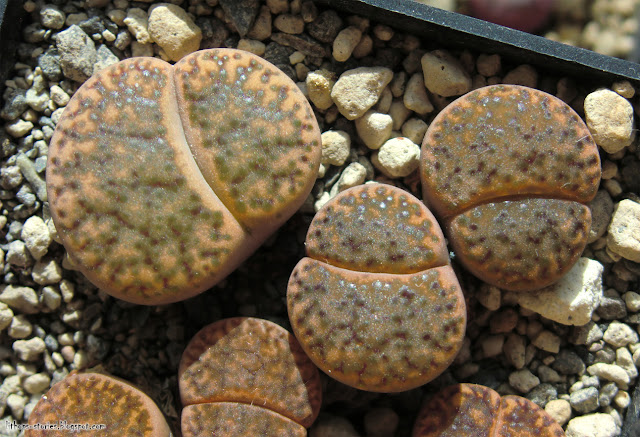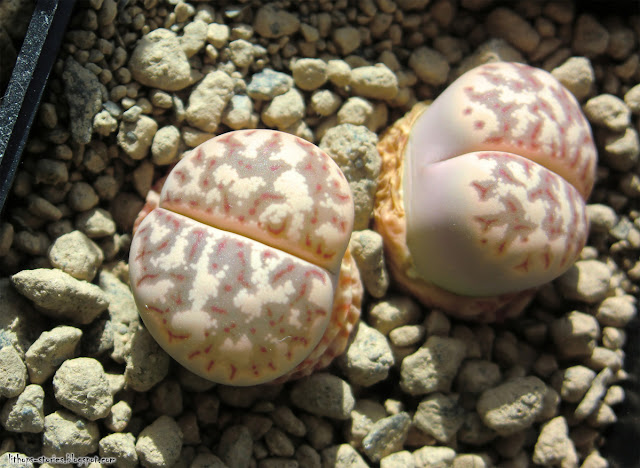As mentioned in the previous installment, I wanted to put the size of my plants on record that "works" under my conditions (sunlight for half a day if any). In my experience, larger plants either die or return to this size after a regeneration or two. Trying to push them to get larger only results in elongated shapes and distorted patterns (and eventually death). I guess, keeping them at a particular (small) size does not give them enough resources to flower every year but that's the price I pay for healthy overall condition, long life and good looks of a plant. The size is being measured across the long side of one head.
I grow a variety of Lithops lesliei and from what I see the older two-headed plants (at least 7 years old) can get pretty large, measuring 1.7 cm per head. Here are some examples.
 This one got a bit bloated after the recent watering and expanded to 2.1 cm. But you can see that that's not normal because the surface is rounded and smooth instead of being flat and furrowed like the ones above.
This one got a bit bloated after the recent watering and expanded to 2.1 cm. But you can see that that's not normal because the surface is rounded and smooth instead of being flat and furrowed like the ones above.According to the books, L. lesliei ssp. lesliei v. mariae are the largest of the L. lesliei and my 7 year old seedlings are all at 1.7 cm if one-headed. The two-headed plants are slightly smaller (1.5 cm) but they'll get there. I believe that none of my mariae seedlings have reached their full potential yet. They grow very slowly.
However, the size of the above plants is not the rule and most of my L. lesliei, regardless of the head count, are at 1.4 cm in average. Some of the below are actually the same variety and age as the above.
This one is also C008 but the size of the heads is 1.1 cm, year after year. Petite.
The biggest of my 6 year old L. lesliei ssp. burchellii (C308) seedlings measure 1.4 cm. Most of them however are still uniformly 1 cm across the long side.
Moving on to L. bromfieldii. The adult L. bromfieldii v. mennellii plants I bought from a specialized local grower a couple of years ago measure 1.4 cm per head. I very much admire that grower so that's my orientation.
My own adult plants are the same size in general.
Some of the 7 year old L. bromfieldii v. glaudinae (C382) reach 1.7 cm while others of the same bunch are as small as 1.2 cm.
Here are some of the bigger plants...
... and here are two of the smaller.
L. schwantesii are also growing up to the size of 1.7 cm without regeneration problems or changing of overall shape on my windowsill. Although half of the plants I own (I have about 20) measures 1.4 cm. I guess anything in between is a good size.
Seeing how many photos I've already posted I will end here and continue the review of the smaller plants in Part 3!





























































